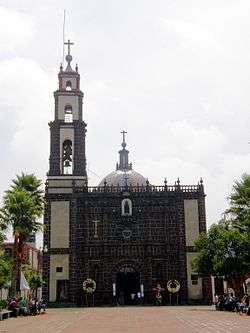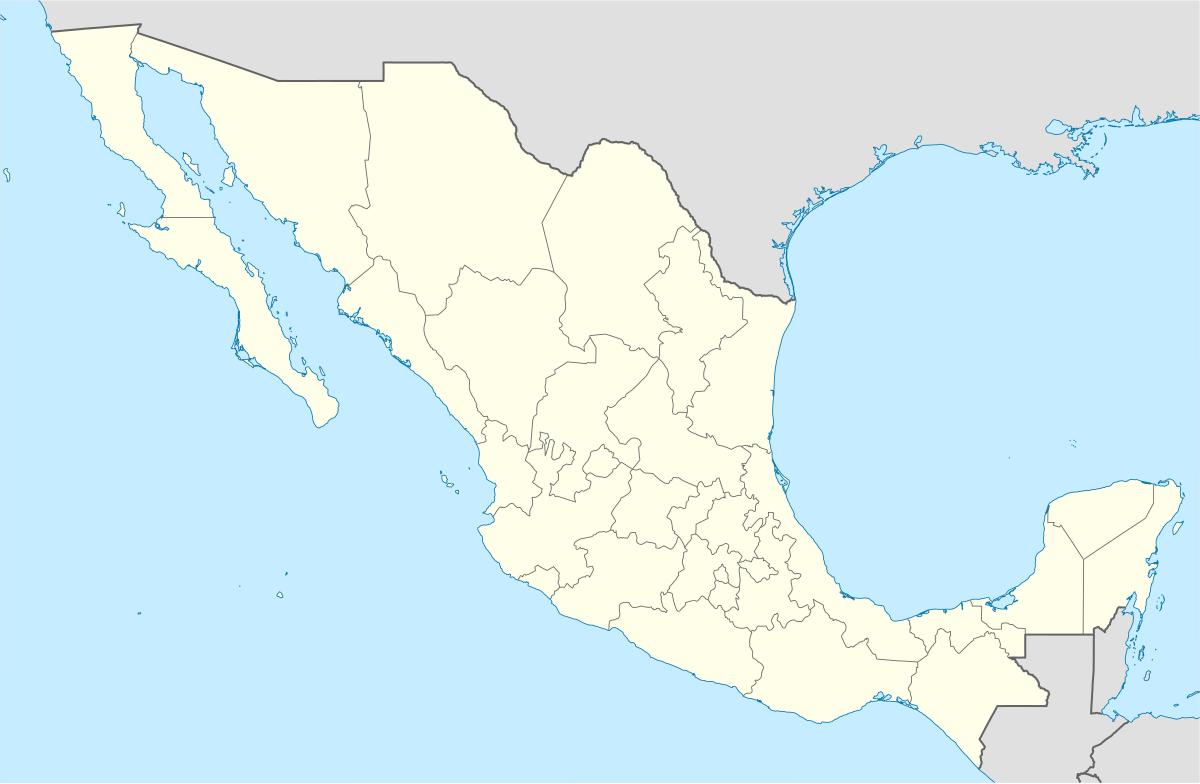Tultepec
Tultepec is a city and municipality located in State of Mexico, Mexico. It lies directly north of Mexico City in the northeastern part of the State of Mexico, making it part of the Greater Mexico City urban area. The name comes from Náhuatl meaning 'hill of the 'tule'.[1] The census of 2005 reported a population of 57,586 for the city and 110,145 for the municipality as a whole.[2]
Tultepec Municipio de Tultepec | |
|---|---|
| Municipality of Tultepec | |
 The Nuesta Señora de Loreto Church in the early 2010s | |
 Seal | |
 Tultepec | |
| Coordinates: 19°41′06″N 99°07′41″W | |
| Country | Mexico |
| State | Mexico State |
| Municipality | Tultepec |
| Government | |
| • Municipal President | Ramón Sergio Luna Cortes (2006–2009) |
| Area | |
| • Land | 25.856 km2 (9.983 sq mi) |
| Elevation | 2,250 m (7,380 ft) |
| Population (2010) | |
| • Total | 91,808 |
| Time zone | UTC-6 (Central (US Central)) |
| • Summer (DST) | UTC-5 (Central) |
The city
The area was first settled by the Chichimecas, followed by the Otomis in the seventh century. After the Spanish Conquest, Tultepec was given to the conquistador Alonso Ávila along with the current municipalities of Zumpango, Xaltocán, Huehuetoca, Coyotepec, Teoloyucan and others, as part of the Encomienda de Cuautitlán. The modern town of Tultepec began to take shape around 1610 in the valley next to a small elevation called San Martín. Franciscans came to evangelize the new community, dedicating it to the Nativity of Holy Mary and constructing a temple in 1618. This temple, later a parish, was renovated between 1948 and 1955.[1]
The town and municipality boast of a number of musicians and painters including Hernesto Urbán Rodríguez (1894), Ricardo Vázquez Pineda (1894), Victor Manuel Urbán Silva (1894), Andrés Urbán (1870) and Prudenciano García (1880), as well as modern composers such as Victor Urbán Velasco, Gerardo Urbán Velásco, Francisco Vázquez García, Francisco Romero Linares, and J. Isabel Vázquez Solano. Better-known painters include Miguel Hernández Urbán, Joaquín González Romero, Margarito González Solano, Gregorio González Solano, and Albino Luna Sánchez. It is the home of a folk dance group that has toured the United States and Europe.[1]
Fireworks industry
In the past, when the town was still rural, the economy was based on products such as pulque, animal feed, salt and tequesquite as well as domestic fowl and other small animals, mostly to be sold in Mexico City.[1]
Nowadays, the pyrotechnics industry is the major industry in Tultepec. Every year, the town throws a weeklong festival with fireworks competitions among various producers.[3]
Many pioneers in pyrotechnics came from Tultepec, including Agustín, Miguel and Gregorio Fiesco (1880); José Solano Urbán (1900–1920), who revolutionized firework sets and castles; Felipe Reyes, who worked on the colors red and yellow around 1920; Ángel Guadalupe Flores, who around 1920 invented star fireworks and sparklers as well a several types of rockets; Cirilo Sánchez (1920), who worked on aerostatic balloons; as well as Tomás Romero, Ángel Urbán Rivero, Marcos Romero, and Felipe Fiesco, who innovated such items as the electric target, the spider bomb, and two-figure wheels between 1930 and 1934.[1]
The city and municipality hosts the annual National Pyrotechnic Festival.
The municipality
As municipal seat, Tultepec has governing jurisdiction over the following communities: Guadalupe, Rancho el Cuquío, Maite (Granja Maite), San Antonio Xahuento, Rancho San Joaquín, Santiago Teyahualco, Rancho la Virgen, Ejido Tultepec, Rancho Nodín, Paraje Trigo Tenco, Ejido de Teyahualco, Hacienda Real de Tultepec, Unidad CTM San Pablo, Barrio de San Martín, Ejido San Pablito (Paraje San Pablito), Colonia las Brisas, La Rinconada, La Saucera, Cajiga (Ejido de Tultepec), El Progreso, Colonia la Aurora and Fraccionamiento Paseos de Tultepec II.[2]
The municipality is bordered by the municipalities of Nextlalpan, Melchor Ocampo, Tultitlán, Coacalco and Cuautitlán. Most of the area is a plain with small hills, the largest of which is called Otzolotepec. Temperatures range between 6 and 28°C, but much of the local ecosystem has been destroyed due to urbanization.[1]
The territory surrounding the town of Tultepec used to be much larger. The current municipality took shape at the end of the 19th century and the beginning of the 20th when areas were split off to create the current municipality of Melchor Ocampo. The municipal palace was constructed in 1870. Tultepec municipality currently has an area of 19.02 km² (7.344 sq mi).[1] Another major town in the municipality is Santiago Teyahualco.
Outside the main town, there is still some agricultural activity including the raising of animal feed, beans, corn, wheat and alfalfa, and the raising of animals such as cattle and pigs, but agricultural land is shrinking. There are over 79 manufacturing establishments in the municipality including Asfalto Industria and Nacional Constructora. Communities involved in the manufacture of fireworks also serve as tourist attractions.[1]
Mammoth skeletons were discovered in Tultepec, Mexico.
Archaeologists have discovered a large trove of mammoth skeletons in Tultepec, north of Mexico City, possibly shedding new light on the hunting habits of prehistoric communities.
Researchers from Mexico’s National Institute of Anthropology and History say they have uncovered what could be the first human-made traps used to capture the Pleistocene animals. 6
The finding represents a significant turning point in researchers’ understanding of the relationship of hunter-gatherer bands with the mammoths, Pedro Francisco Sánchez Nava, the institute’s national coordinator of archaeology, said in a statement on Wednesday. 7
References
- "Enciclopedia de los Municipios de Mexico Estado de Mexico Tultepec". Retrieved 2008-08-04.
- "Link to tables of population data from Census of 2005] INEGI: Instituto Nacional de Estadística, Geografía e Informática". Archived from the original on 2013-02-27. Retrieved 2008-03-28.
- "Tultepec Pyrotechnics". Retrieved 2008-08-04.
- "At least 35 dead, dozens injured after explosion at Mexico fireworks market". Fox News. 20 December 2016. Retrieved 20 December 2016.
- Mexico's 'capital of pyrotechnics' has experienced at least 8 fireworks explosions in the past 20 years businessinsider.de, 21 Dezember 2016, retrieved 14 March 2017.
6. https://www.inah.gob.mx/en/boletines/8647-descubren-en-tultepec-estado-de-mexico-contexto-inedito-de-caceria-y-destazamiento-de-mamuts 7. https://www.nytimes.com/2019/11/08/science/mexico-mammoth-traps.html?te=1&nl=science-times&emc=edit_sc_20191112?campaign_id=34&instance_id=13791&segment_id=18720&user_id=a3a2acedecd9fe3d360d9d0fb5e7888f®i_id=88447739
External links
- Official website (in Spanish)
